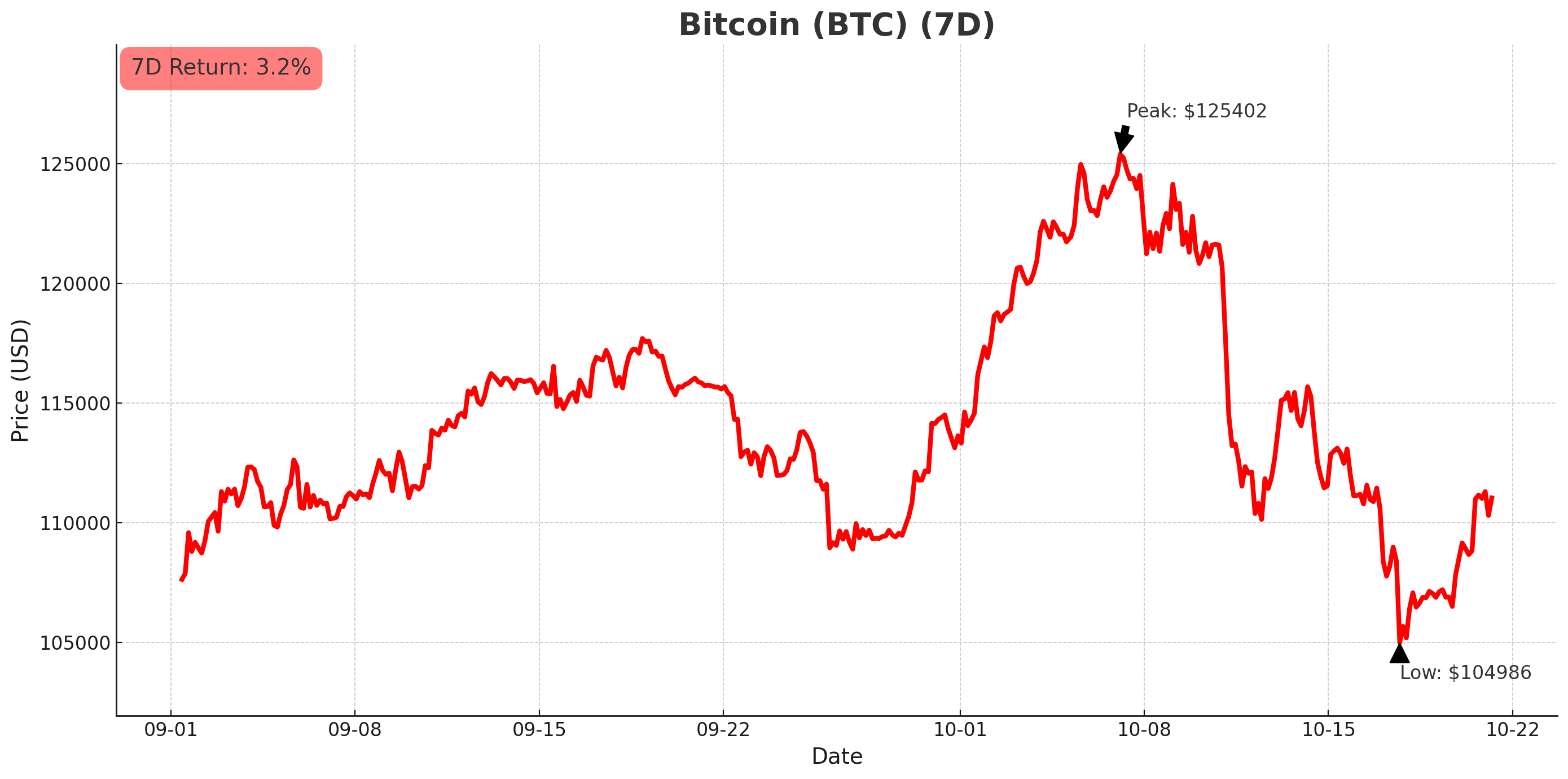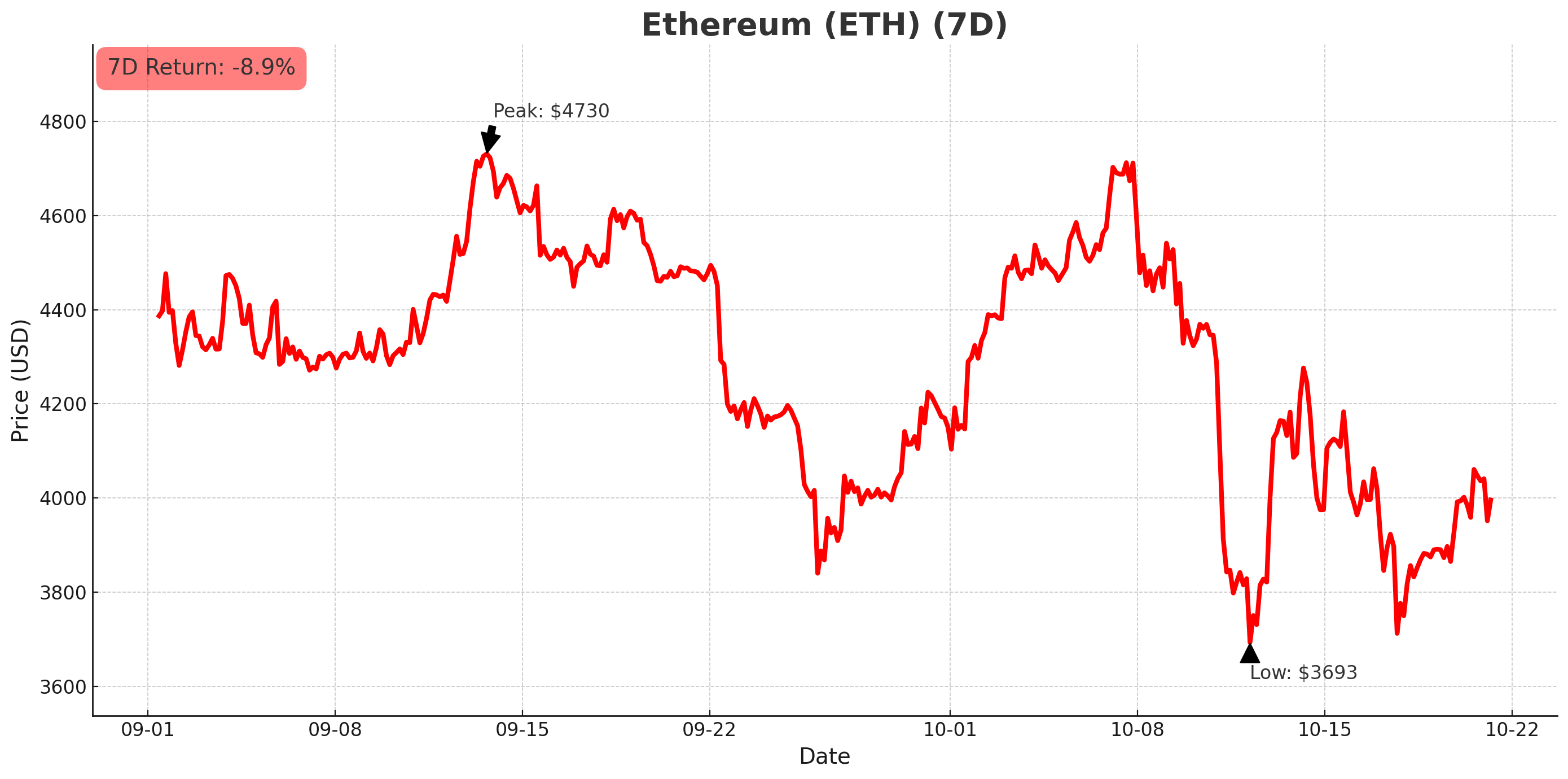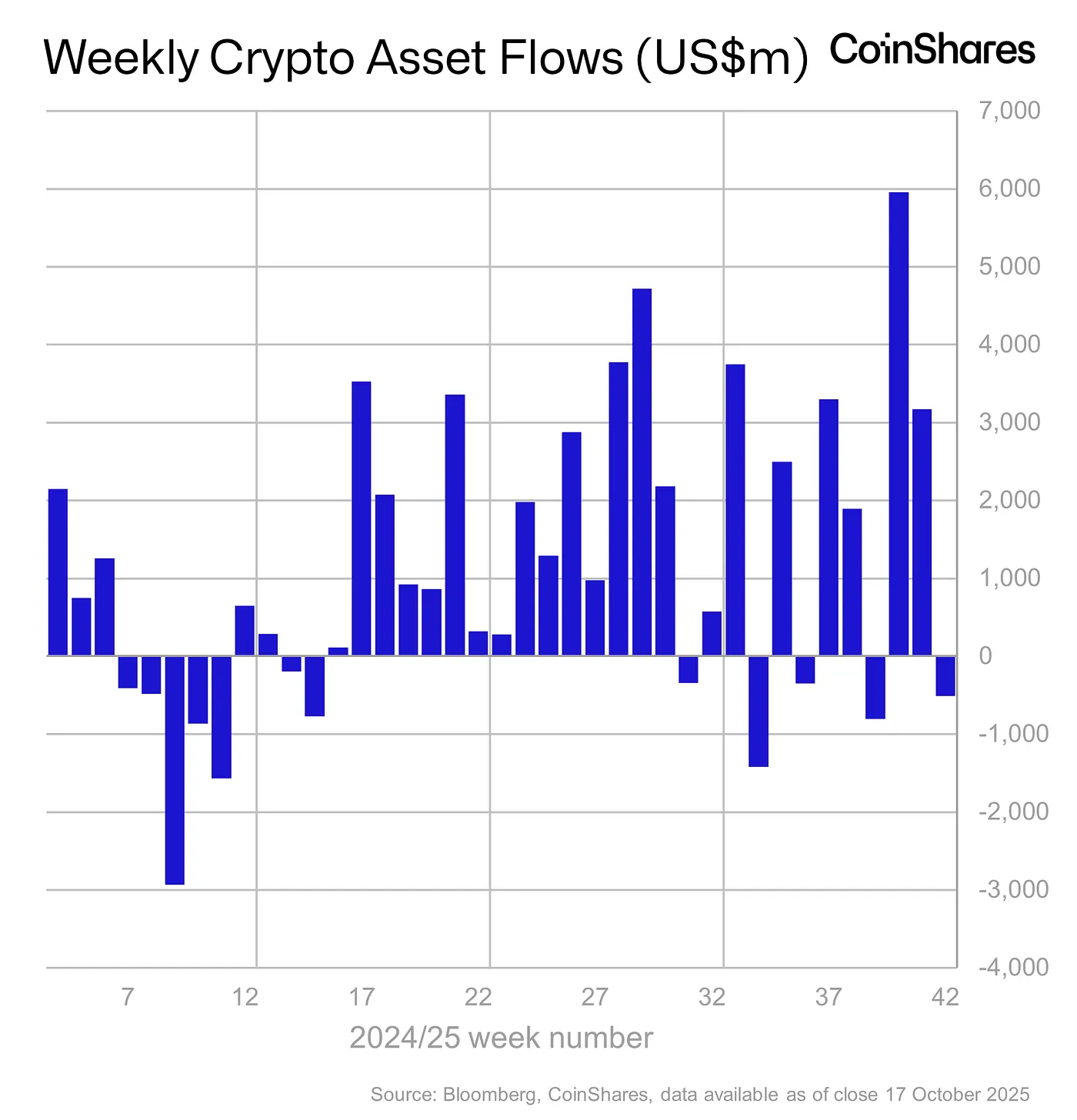Market highlights
- The U.S. Government seized US$14.4 billion of BTC from a global crypto scam operation.
- The Fed will hold a crypto conference, covering a range of topics, on October 21.
- Zeta Network Group secured a US$231 million private placement, payable in bitcoin.
- Stripe’s blockchain project, Tempo, raised US$500 million in a Series A funding round.
- Peter Thiel-backed Erebor Bank was granted a conditional federal banking charter.
- The Retirement Investment Choice Act was introduced in the U.S. House.
Markets Overview
Risk assets failed to make new highs this week following the October 10 sell-off, though President Trump’s comments that the threatened 100% tariff on China would be unsustainable saw the major indexes climb to end the week. It followed a sell-off on Thursday, October 16, driven, in part, by regional U.S. bank Zions Bancorporation (ZION) disclosing losses related to two commercial and industrial loans, though the affected companies’ stocks regained the following day. Also this week, gold continued its historic run, making a new all-time high of US$4,380 per ounce.
Economic data remained quiet this week as the U.S. government shutdown entered its third week. U.S. Federal Reserve Chair Jerome Powell spoke on Tuesday, October 14, hinting at an October rate cut and potential end to quantitative tightening (QT), driving minor gains for risk assets.
Looking to the week ahead, Treasury Secretary Scott Bessent and Chinese Vice Premier He Lifeng are scheduled to meet, while a U.S.-China summit may occur at the next Asia-Pacific Economic Cooperation (APEC) meeting on October 31. Also this week, Netflix, Coca-Cola, Tesla, IBM and Intel will release their Q3 results.
Weekly performance: S&P 500 +1.7%, Dow Jones +1.6%, Nasdaq +2.1%.
Looking ahead:
- Flash Manufacturing PMI & Flash Services PMI (U.S., U.K., and Germany) – Friday, October 24 (U.S. data releases tentative due to government shutdown)
- U.S. core CPI – Friday, October 24
Crypto Market Sector Performance
Declines continued across most crypto sectors this week. The largest downside moves were seen in staking services, presumably as traders and investors de-risk their portfolios following recent sell pressure.
As the dust settles on the October 10 sell-off, JP Morgan released a note to clients, stating that recent sell pressure came from crypto-native investors. Amidst the sell-off, almost US$12 billion in futures open interest closed, while ETF flows and CME’s bitcoin open interest remained steady. This suggests that institutional capital remained on the sidelines throughout the recent volatility, while crypto whales and those who believe in the four-year crypto cycle sold, presumably as TradFi intends to maintain long-term exposure to crypto regardless of short-term fluctuations.
Biggest loser
- Staking services: EigenCloud (-19.9%) declined following sell pressure due to the announcement of its 36.8 million token unlock (around 12.1% of supply), which will occur on November 1, as weakness across crypto continued. Eigen Labs’ Chief Growth Officer, J.T. Rose, spoke at DAS London this week, highlighting Eigen’s three core use cases: autonomous trading agents, agent-to-agent payments, and gaming with attestable outcomes.
Bitcoin (BTC)
- Opened the week at US$115,067 and sold off to a four-month low of US$103,516 on continued U.S.-China trade tensions and weakness across the crypto market following the October 10 sell-off. Price has since recovered to trade around US$110,500 (-4.4% 7D).
- BTC dominance hovered around 59.5% this week.
- Bitcoin investment products saw almost US$946 million of outflows this week.
The Nasdaq and bitcoin’s correlation decoupled this week after being correlated for much of 2025. The divergence started from October 15, when the Nasdaq was up 0.4% on the week, while BTC had declined by 3.7% and crypto liquidations reached US$524 million. On-chain analysis indicates that the October 10 sell-off, which saw US$19 billion in liquidations, and subsequent weakness across crypto, is the cause.
Between August and mid-October, stablecoin inflows to exchanges typically used for spot buying declined, while inflows to derivatives exchanges, which are often used for collateral to maintain leveraged positions, increased. This synthetic demand could explain bitcoin’s recent rally to over US$125,000 and the sharp decline as leveraged positions were liquidated and traders continue to de-risk following the sell-off. Progress on U.S.-China trade negotiations and strong macro data could see some bullish sentiment return to bitcoin.
The U.S. Government seized US$14.4 billion worth of bitcoin from the alleged head of a global crypto scam operation, the Huione Group. The group forced people to help operate its “pig butchering” scams for 16 hours a day in Cambodia. Prosecutors have filed to claim the funds through criminal forfeiture, so it is unclear whether the bitcoin will be repatriated to the victims or the BTC will be added to the country’s strategic bitcoin reserve.
Zeta Network Group (Nasdaq: ZNB) has secured a US$231 million private placement, payable in bitcoin or wrapped-Bitcoin token SolvBTC, issued by Solv Protocol. The capital raise will issue Class A shares and warrants, strengthening Zeta’s balance sheet as it diversifies into holding BTC.
In bitcoin buying news:
- Strategy bought 168 BTC, bringing its total holdings to 640,418 BTC at an average purchase price of US$74,010 per bitcoin.
- Newsmax, a publicly traded media outlet, is establishing a digital asset treasury worth up to US$5 million over the next 12 months. The treasury will be centred around bitcoin and President Trump’s meme coin, TRUMP.

Past performance is not a reliable indicator of future results.
Ethereum (ETH)
- Opened the week at US$4,156 and declined to a weekly low of US$3,673 as weakness across the crypto market continued. Price has since regained to around US$3,900, showing potential signs that the recent sell-off may have reached a floor. (-6.7% 7D).
- Ethereum dominance hovered between 13% and 12.8% this week.
- Ethereum-focused funds saw inflows of US$205 million this week.
Crypto venture capital firm Paradigm’s influence within the Ethereum ecosystem is being flagged as a potential “tail risk,” warns core dev Federico Carrone. While the company has contributed significantly to the network, Carrone argues its growing sway may shift Ethereum’s priorities away from decentralised values. Amongst other crypto projects, Paradigm has also invested in layer-1 blockchain, Tempo, which is a partnership with Stripe.
In Ethereum buying news:
- SharpLink Gaming announced a US$76.5 million share offering to fund further ETH purchases. The company currently holds 840,124 ETH, valued at almost US$3.4 billion.
- BitMine bought a further 202,037 ETH, bringing its holdings to over 3 million ETH, worth more than US$12.5 billion.
- EthZilla (ETHZ) announced a 1-for-10 reverse stock split to strengthen its engagement with institutional investors. ETHZ shares declined by 5% on the announcement. The company currently holds 102,246 ETH, worth US$407 million.

Past performance is not a reliable indicator of future results.
Altcoins
The altcoin season index is currently at 39 as bearish sentiment continues.
End of an alliance
- Artifical Superintelligence Alliance (FET) declined by 27.8%. The sell pressure continued following the broader market declines and Ocean Protocol’s sudden exit from the alliance on October 9. The rise of other AI-focused crypto projects, such as Bittensor (TAO), especially as Ocean Protocol is reportedly in talks to create a subnet on the Bittensor network, is creating bearish sentiment for FET.
DEX declines
- Aster (ASTER) lost 20.9% as the last few week’s of substantial gains for the decentralised exchange network settled. This week’s declines are presumably due to DeFiLlama delisting and then relisting ASTER, stating that its trading data, particularly volume, is “still a black box”.
Tell me a story
- Story (IP) declined by 20.4%. The network, which tokenises IP and makes it programmable, has sold off since reaching an all-time high of US$14.89 on September 22. This week’s sell pressure is presumably due to broader market weakness. Its announcement of a strategic partnership with Lombard, a bitcoin DeFi platform, to redefine how creators monetise their work with bitcoin-backed products, did little to move price.
Ripple effect
- XRP (XRP) declined by 4.7%. Like other major layer-1 networks, the declines were smaller than many altcoins this week. And, XRP could see a bid on the announcement of the newly formed Evernorth Holdings Inc., which will merge with the special purpose acquisition company (SPAC), Armada Acquisition Corp II. to establish an XRP treasury company. The US$1 billion raise to establish the company is expected to close in the Q1 2026, and has seen investments totalling US$200 million from SBI, Ripple, Rippleworks, Pantera Capital, and Kraken, to name a few.
Crypto ETF News
Digital asset investment products saw outflows of US$513 million this week. The outflows were minor compared to broader liquidations across the crypto market, suggesting that ETF holders weren’t as bearish about the October 10 sell-off. The outflows were led by bitcoin, while some altcoins, such as Solana and XRP, saw inflows on interest around upcoming exchange-traded fund (ETF) launches for these assets. Solana saw inflows of US$156 million and XRP saw inflows of US$73.9 million.
ETF volumes this week, remained elevated at US$51 billion, almost double the weekly average throughout 2025.
ETF manager, Volatility Shares, filed with the U.S. Securities and Exchange Commission (SEC) to launch crypto ETFs offering 5x exposure to bitcoin, Ethereum, Solana, XRP and crypto-related stocks. Also this week, VanEck filed to launch the Lido Staked Ethereum ETF, 21Shares filed to launch a leveraged Hyperliquid ETF offering 2x exposure, and ARK invest filed to launch three new bitcoin ETFs. ARK invest’s three new BTC ETFs are: the ARK Bitcoin Yield ETF, which is designed to generate yield on BTC, the ARK DIET Bitcoin 1 ETF (offering 50% downside protection), and the ARK DIET Bitcoin 2 ETF (offering 10% downside protection).

Other crypto news
- The U.S. Federal Reserve will hold a crypto conference, covering bitcoin, digital assets and crypto payments, on October 21. Regulators, financial executives and crypto industry leaders will attend the event. Four panel discussions will take place throughout the day. The first will cover bridging TradFi and digital assets, the second will focus on stablecoin use cases and business models, the third will focus on AI in payments, and the fourth will focus on tokenised products. No policy announcements are expected from the event.
- Beijing has instructed major tech firms, including Ant Group and JD.com, to halt their stablecoin plans in Hong Kong over concerns that private-sector digital currencies could challenge state monetary control. It follows the approval of Hong Kong’s new licensing regime for stablecoins earlier this year. Beijing has since stated its intention for the regime is “designed to absorb foreign crypto capital, not serve as a conduit for domestic mainland transactions”. Despite the direction from Beijine, Ant Group launched Jovay this week, a new layer-2 blockchain on Eterheum designed to tokenise and move real-world assets.
- Japan’s top three banks, Mitsubishi UFJ Financial Group, Sumitomo Mitsui Financial Group and Mizuho Financial Group are working together to jointly issue stablecoins. The coins will be pegged to the value of real-world currencies, allowing corporate clients to use the stabelcoins to transfer value between them.
- Hyperliquid launched its permissionless builder-deployed perpetual markets (perps), HIP-3, which allows users to create perps without authorisation. It’s the biggest development in the network’s history. Qualified developers will be able to deploy perps by staking 500,000 HYPE tokens.
- Stripe’s blockchain project, Tempo, has raised US$500 million in a Series A funding round, valuing the payments-focused Layer 1 blockchain at about US$5 billion. The project also hired Dankrad Feist, an Ethereum Foundation researcher. Some have supported Feist’s new role, including Vitalik Buterin, while others criticised it as giving up open-source ideals for corporate blockchain and crypto projects.
- BlackRock has restructured its Select Treasury Based Liquidity Fund (BSTBL) to cater to U.S. stablecoin issuers. As part of the restructure, BSTBL will shorten the maturity of its U.S. Treasuries holdings and add overnight repurchase agreements as an eligible asset to comply with the GENIUS Act while maximising liquidity for stablecoin issuers.
- Erebor Bank, backed by prominent figures including Palmer Luckey and Peter Thiel, has been granted a conditional federal charter by the Office of the Comptroller of the Currency (OCC). The move positions Erebor as a frontrunner in issuing stablecoins under the new GENIUS Act framework, intensifying the U.S. stablecoin “arms race”. In other banking news, Citi plans to introduce crypto custody services from 2026, as TradFi firms continue adding to their crypto offerings.
- House of Representatives member Troy Downing (R-MT) introduced the Retirement Investment Choice Act. The Act aims to codify Donald Trump’s August executive order that opened 401(k) plans to alternative assets, including cryptocurrencies. The bill would mandate retirement providers to offer exposure to crypto-linked funds, potentially unlocking billions in new capital for digital assets.



